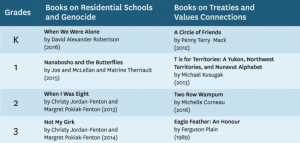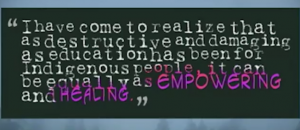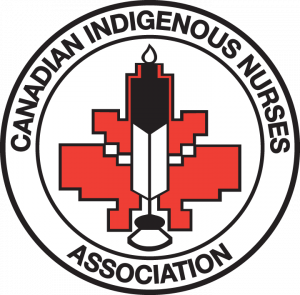This website provides stories of those individuals who were survivors in residential schools. These videos would be beneficial to share with your students as they are real stories from their time in these schools. Even though there are storybooks and videos that we can share with our students, having an individual speak about their trauma can have more of an impact, I believe. Even if you believe that your students are not ready to listen to these stories, it would be extremely beneficial for us, as educators, to listen to these real-life stories so that we can have a fuller picture of what exactly happened in these schools. These stories will allow us to understand the trauma that was faced during their time at these school, and to help us educate our students. I am not saying to tell their stories, as they are not our stories to tell, but to have more of an understanding so that we will be able to have deep conversations with our students to allow them to comprehend their Canadian history. Many of these videos were hard to listen to as their feelings are still extremely raw, however, it will be powerful for you to have a listen.
Tag Archives: reconciliation
Module 3 – Post 3 – Truth and Reconciliation
I came across this article that focuses on truth and reconciliation from K-12. This article discusses how teachers can become an ally. There were a couple of things that stood out to me. Firstly, I thought it was extremely useful and helpful that there was a complete list of books from K-12 that teachers can use and read in their classrooms to teach students about reconciliation. I appreciate that there are two books for each grade, however I wish there were more than just two. Hopefully in the near future there will be tons more books available that we can use in the classroom. Below are the books for primary classes.

Another section of this article that grabbed my attention was The Sacred Circle. This circle could help educators learn how to become an ally through the spiritual, physical, emotional, and intellectual teaching. According to this article by Dr. Pamela Rose Toulouse (2018),
“The spiritual invites the educator to examine all the opportunities that their lessons, field trips and experiential learning activities offer to link students to each other, their communities and the globe. This aspect of holism in teaching/learning places emphasis on activities that develop deep and meaningful connections with a purpose “greater than the self.”
The physical refers to the classroom space/s where learning takes place and encourages differentiated practices outdoors and in the community. This aspect of holism encourages teaching/learning at sites that make connections to local events, people, places and movements
The emotional concerns the inclusion of Elders, Métis Senators, Cultural Resource People, families and non-human experiences as foundational to the classroom and school year. This aspect of holism values the knowledge that “other teachers” bring to the shared world of education.
The intellectual refers to the provincial/territorial mandated curriculum that the educator is entrusted with delivering to the students. This aspect of holism calls upon the educator to factor in inquiry, curiosity and differentiated evaluation as critical to meaningful student experiences in school” (para. 12).
The more we know, the more we can do. It starts with us, as educators, to have a role to play in this learning process and journey towards truth and reconciliation.
Module 3 – Post 2 – Spirit Bear and Children Make History: Learning Guide

The Spirit Bear and Children Make History: Learning Guide is a guide that focuses on telling the “story of a landmark human rights case for First Nations children at the Canadian Human Rights Tribunal” (para. 1). This guide was written to cater the younger crowd and engage them in learning about human rights and to establish the influential role that younger individuals have in the reconciliation movement. On page 6 of this guide, it points out all the outcomes children will have after reading this book (PDF of this storybook in Cree and in English). I wanted to share these outcomes because even though this guide is geared towards younger students, their learning potential is huge.
It states that students will:
“• have a greater understanding of inequities facing First Nations children, which compromise their health, safety, and well-being,
• develop empathy and critical thinking,
• develop citizenship and life skills such as problem-solving, decision-making, understanding of personal and social responsibility, ethics, courage, self-confidence, creativity, collaboration, and communication skills (be able to express themselves and articulate their ideas),
• be able to describe how children can help implement the Truth and Reconciliation Commission’s Calls to Action,
• recognize that their voices and ideas matters and that children have the power to influence the world around them, and
• recognize that true heroes are those who are courageous enough to stand up for what is right and not give up, even when it is hard to be brave” (p. 6).
I like this resource as it provides some school-base activities that you can do with your students to learn about reconciliation through storytelling and engaging activities. This true story book is one that I would like to buy to add to my classroom collection.
M3, Entry 1: Why Indigenization Matters
Module 3: Decolonization and Indigenous Property Rights
Entry 1: Why Indigenization Matters
This interview with Vianne Timmons, President and Vice-Chancellor, University of Regina gives an overview of the definition of Indigenization and what is being done at the University of Regina to ensure that all students are provided with an education that better prepares them for a reconciled world.
In a follow up interview, Timmons provides a practical list of action items for Indigenization.
Looking further, the Office of Indigenization website provides links to the strategic plan of the University of Regina that provides more detail.
References
Eduvation, (2018). 100 ways to indigenize your campus: Vianne Timmons at the University of Regina. [Video]. YouTube. https://www.youtube.com/watch?v=CLVYgAmZuxA.
Eduvation, (2018). Why indigenization matters: Vianne Timmons at the University of Regina. [Video]. YouTube. https://www.uregina.ca/indigenization/index.html.
University of Regina (2021). Office of Indigenization. https://www.uregina.ca/indigenization/index.html.
M3P2: The Canadian Indigenous Nurses Association
In 1974, a number of nurses with Aboriginal ancestry joined together with others to form the Aboriginal Nurses Association in 1975, which then became the Canadian Indigenous Nurses Association.
As part of their mandate, the CINA helped inform the Federal/Territorial/Provincial Workforce committee on Health Workforce in their work with the Principle Nursing Advisors Taskforce in 2017 to develop a vision for the future of nursing in Canada that included Indigenous Health. In 2020, the report was published and included numerous strategies and recommendations for involving Indigenous people, Indigenous nurses and nursing schools to improve the health of Indigenous peoples in Canada.
Despite this work by and for nurses, the systems involved are slow to respond, and Indigenous people continue to have poor health outcomes, higher rates of suicide, higher rates of drug and alcohol use, and higher rates of incarceration than the Canadian average (Statistics Canada, 2021). These indicators also clearly indicate symptoms resulting from a legacy of trauma.
While many governmental organizations have commitments to Indigenous health, acknowledgement of Indigenous peoples and multiple task forces and working groups, there doesn’t seem to have been much progress made to improve Indigenous health and well-being.
The mandate of the CINA continues to work on this more specifically with nursing health professionals, as demonstrated by their key objectives. However, there is still much work to be done.
The Association’s key objectives were updated in 2010 to be more reflective of current changing health, social and political environment:
- To work with communities, health professionals and government institutions on Indigenous Health Nursing issues and practices within the Canadian Health system that address particular interest and concern in Indigenous communities with a view to benefiting Indigenous peoples of Canada by improving their health and well-being, physically, mentally, socially and spiritually.
- To engage and conduct research on Indigenous Health Nursing and access to health care as related to Indigenous Peoples.
- To consult with government, non-profit and private organizations in developing programs for applied and scientific research designed to improve health and well-being in Indigenous Peoples.
- To develop and encourage the teaching of courses in the educational system on Canadian Indigenous health, Indigenous knowledge, cultural safety in nursing and the health care system and/or other educational resources and supports.
- To promote awareness in both Canadian and International Indigenous and non-Indigenous communities of the health needs of Canadian Indigenous people.
- To facilitate and foster increase participation of Indigenous Peoples involvement in decision-making in the field of health care.
- To strengthen partnerships and develop resources supporting the recruitment and retention of more people of Indigenous ancestry into nursing and other health sciences professions.
- To disseminate such information to all levels of community.
Canadian Indigenous Nurses Association. (n.d.). Canadian Indigenous Nurses Association (C.I.N.A). Https://Indigenousnurses.Ca. https://indigenousnurses.ca/about
Statistics Canada. (2021, June 28). Indigenous peoples. Https://Www.Statcan.Gc.ca/Eng/. https://www.statcan.gc.ca/eng/subjects-start/indigenous_peoples
Module 4 Post 4: truth first, then reconciliation
McMaster University hosted a MIRI Indigenous Governance Symposium. The government does a good job promoting a reconciliation agenda. But we need to examine the government’s work carefully. The Canadian government is not exposing the entire truth. We can’t jump to reconciliation without addressing the truth. As a non-Indigenous educator I need to ensure that I turn to reliable sources for guidance to support my work in Indigenization. It makes sense to address the truth before reconciling anything. How can Indigenization efforts be genuine if truths are not disclosed?
https://www.youtube.com/watch?v=4qttzjHTjwE
Reference:
McMaster University. (2019 January, 20). 10 Principles to decolonization – MIRI Indigenous governance symposium. [Video]. Youtube. https://www.youtube.com/watch?v=4qttzjHTjwE
Module 3 – Post 1 – The Secret Path
Gord Downie’s The Secret Path is an animated film with music that visually describes Chanie Wenjack’s story escaping residential school. Chanie does not make it home as he dies while attempting to walk over 400 miles to his family. Depending on the students in your class, you could show this if you believe it to be suitable. From 2:38 – 46:12 this film can be shown all at once or in chapters depending on the age of the students and their ability to sit still. This film can show students the story and experience of one child who was forced into the residential school system. This film is even beneficial for adults who are unaware of what children faced during their time at residential schools. Lesson plans on The Secret Path film can help to engage students and teachers in Reconciliation.
This website has lesson plans for primary, intermediate, and high school students. For my classroom, I would use the two lesson plans (When We Are Alone and The Best Part of Me) as I usually teach Kindergarten and Grade 1. With these lessons, students do not have to watch the film if you believe it would not be suitable for them, however, there are pictures that can be viewed instead or you could pause the film at any point to discuss what they see.
As well, in addition or even separate from watching the film, teachers could describe Chanie’s Life Journey through an interactive story map which describes who Chanie was, a short Heritage Minute of Chanie’s story by Historica Canada, an interactive map of where his home and school were, and clips from the The Secret Path film.
Additional information of The Secret Path can be found on this website.
Module 2: Post 4 – Thalit Sqwelqwel Stories of Truth

Thalit Sqwelqwel Stories of Truth has teacher resources from K-12. Since I teach primary students, I wanted to focus on resources suitable for K-3 students . There are four sections: Xwexwa’ls Xwe’Ilsolem precontact, Staleta Skwul Residental Schools, Shxwyayametel Reconciliation, and Shxwi’Aylexw Saliwes Worldviews.
When you click Xwexwa’ls Xwe’Ilsolem precontact there are areas that educators can explore with their classroom. In this section there is the Skwolkwelt Sememlat anchor resources, Kwoles Ye Selyolexwe elder’s corner, and the Lhe’a Kw’e Slilsleqalqel tour. In this area, there is an inquiry question (What are the many ways we can acknowledge the history and knowledge of the land pre-contact and work to share the knowledge with each other?) that educators can pose to their students and open the floor for discussion. Then there are videos of storytelling that can be watched, audios that can be heard, and a visual tour of Lhe’a Kw’e Slilsleqalqel. There are also five digital resources that teachers can use to to learn about different Indigenous cultures.
When you click Staleta Skwul Residental Schools, there are also anchor resources, an elder’s corner, and a tour. Educators can learn and teacher their students about residential schools by starting with an inquiry question (What are the many ways we can acknowledge Mission’s own part in the residential school experience by giving voice to our Elders and members of our community?), using lesson plans that are provided, listening to an elder’s experience at residential schools, and then there is a tour of a residential school.
When you click Shxwyayametel Reconciliation, there are anchor resources and an elder’s corner. The inquiry question in this area is What are authentic ways we can honour the reconciliation process in our hearts, thoughts and deeds? Students can then watch videos of students who participated in acts of Reconciliation at a site of a residential school. There are also lesson plans that teachers can use for Orange Shirt Day for K-12 students. Then in the elder’s corner, an elder discusses how Reconciliation occurs today and how Sq’ewlets are learning about their history, their own people, and their significance to the Sto:lo People.
Finally, when you click Shxwi’Aylexw Saliwes Worldviews, there are anchor resources and the elder’s corner. The inquiry question is How can our exploration of Aboriginal values across the globe promote change and create a positive learning environment for ourselves, our students, our families and our land? Teachers can show their students two videos: one is a documentary of Sto:lo Peoples in the past and present and the Seven Sacred Teachings. In the elder’s corner, elder’s share their stories, knowledge, and advice with youth.
This resource would be a great addition to add to the content I teach students each year.
MODULE 2 – Entry 3: Revising Teaching Practices in Canada with Respect to Indigenous Youth and History
In this presentation https://www.youtube.com/watch?v=fbQGhP4xQkw, Anne Tenning tackles the issues faced by her own experiences and those of the Indigenous youth in the education system. She discusses approaches that educators can take to improve representations of and engagement with Indigenous peoples and their histories in the classroom.
This presentation by Anne Tenning is part of the “Teaching and Communicating Indigenous History” Panel at the 9th Canada’s History Forum, Engaging Authentic Indigenous Histories that was held on November 27, 2016 in Ottawa. This event was organized by Canada’s National History Society and the National Centre for Truth and Reconciliation. Anne speaks of educators who continue to commit themselves to seeing the reconciliation of Indigenous students and how she was given more opportunities to succeed because she knew one teacher who made a life-changing difference in her life.

Quote by Anne Tenning, found in the same link below.
Reference:
Canada’s History. (January 13, 2017). Revising Teaching Practices in Canada with Respect to Indigenous Youth and History. [Video].YouTube. Retrieved May 24, 2021, https://www.youtube.com/watch?v=fbQGhP4xQkw
M1: P5: Reconciliation Through Indigenous Education taught by Jan Hare through Associate Dean for Indigenous Education at UBC
This course came to my attention through an ETEC 512 discussion on “How will MOOCs (massive open online courses) revolutionize education?” It is also offered by one of the authors of this week’s readings, Jan Hare. I have yet to take Hare’s course, “Reconciliation Through Indigenous Education”, but I vowed to look into taking it after I finish this program, rationalizing that it “provides a vessel to reach out to Canadians to address the issues facing our country’s history.” Although this may not be a resource accessible right now to us in this course, it is important that educators consider joining a course like this to reach out to and connect with students that we have in our classrooms.
